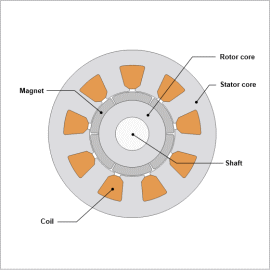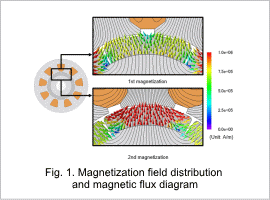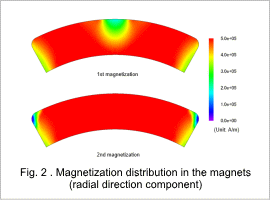*Please prepare a license ID and password for the license administrator.
*It is different from the service for JMAG WEB MEMBER (free membership). Please be careful.
Overview

Permanent Magnet Synchronous motors (PMSM) sometimes use a method known as integrated magnetization. This is where magnets are assembled without magnetization then magnetized after the assembly. Depending on the combination of the number of poles and slots, the magnets may not be sufficiently magnetized by just one magnetization. The magnets are then magnetized more than once by rotating the rotor or changing the current values. In situations like these, the design must prevent the irreversible demagnetization of the magnets that have been previously magnetized.
By using a magnetic field analysis simulation which uses the finite element method, you can check the magnetization distribution that occurs in the magnets as the result of the magnetization conditions. By accounting for magnetic hysteresis during this process, the magnetization distribution in the magnets can be evaluated at a higher accuracy.
In this example, the magnets are magnetized more than once with the rotor at different positions to evaluate the magnetization distribution in the magnets while also accounting for hysteresis.
By using a magnetic field analysis simulation which uses the finite element method, you can check the magnetization distribution that occurs in the magnets as the result of the magnetization conditions. By accounting for magnetic hysteresis during this process, the magnetization distribution in the magnets can be evaluated at a higher accuracy.
In this example, the magnets are magnetized more than once with the rotor at different positions to evaluate the magnetization distribution in the magnets while also accounting for hysteresis.
Magnetization Field Distribution

The magnetization field distribution and the magnetic flux line diagram when the magnetization current is 1 kA are shown in Fig. 1.
The magnets are evaluated for the 1st and 2nd magnetizations. In the analysis, the magnets are evaluated as being arranged in the same positions. In the diagram, the stator side is shown as having been rotated. Note that the magnets are arranged in a radially outward orientation direction.
In the 1st magnetization, the magnetic fields are weak in the center of the magnet because the center of the magnetic pole faces the slot opening part. To ensure that the magnets are fully magnetized, for the 2nd magnetization, the magnetic pole instead faces the center of the tooth. Looking at the magnetization distribution of the 2nd magnetization, we see this occurring in the opposite direction of the orientation direction at the ends of the magnet.
The magnets are evaluated for the 1st and 2nd magnetizations. In the analysis, the magnets are evaluated as being arranged in the same positions. In the diagram, the stator side is shown as having been rotated. Note that the magnets are arranged in a radially outward orientation direction.
In the 1st magnetization, the magnetic fields are weak in the center of the magnet because the center of the magnetic pole faces the slot opening part. To ensure that the magnets are fully magnetized, for the 2nd magnetization, the magnetic pole instead faces the center of the tooth. Looking at the magnetization distribution of the 2nd magnetization, we see this occurring in the opposite direction of the orientation direction at the ends of the magnet.
Magnetization Distribution of the Magnet Positioned in the Air

The magnetization distribution (radial component) of the magnet positioned in the air when the 1st and 2nd magnetizations end respectively is shown in Fig. 2.
Looking at the magnetization distribution when the 1st magnetization ends, we understand that the magnetization is weaker at the center of the magnetic pole. Looking at the magnetization distribution when the 2nd magnetization ends, the magnetization has increased at the center of the magnetic pole, but compared to the 1st magnetization, magnetization has reduced at the ends of the magnet. From this we understand that irreversible demagnetization has occurred. As shown by the magnetization field distribution in Fig. 1, this is because magnetic fields are generated in the opposite direction in the 2nd magnetization.
Looking at the magnetization distribution when the 1st magnetization ends, we understand that the magnetization is weaker at the center of the magnetic pole. Looking at the magnetization distribution when the 2nd magnetization ends, the magnetization has increased at the center of the magnetic pole, but compared to the 1st magnetization, magnetization has reduced at the ends of the magnet. From this we understand that irreversible demagnetization has occurred. As shown by the magnetization field distribution in Fig. 1, this is because magnetic fields are generated in the opposite direction in the 2nd magnetization.


